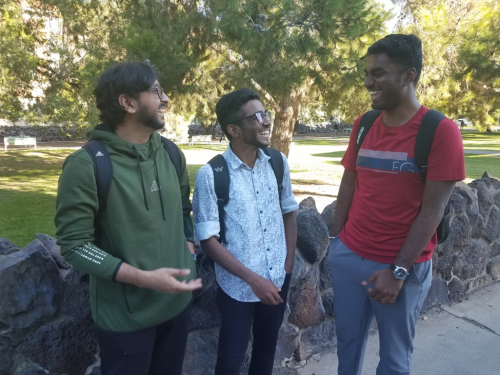
Tanya Ence, El Inde Arizona
For the first time in almost 20 years, the number of students from India outnumber Chinese students at the University of Arizona, making Indian students the largest international student group on campus.
Together, Indian and Chinese students make up almost 40% of the entire UA international student population represented by individuals from 127 different countries.
The UA census records show that since 2004, Chinese students have represented the largest international student group on campus. This year Indian student totals edged ahead by a percentage point.
Indian students now comprise 20% of UA’s international students.
Bruce Wang, senior director of Asian engagement at UA, attributes the decline in Chinese student enrollment to COVID’s “lagging effect,” as well as “geopolitical tension between the two countries.” He said the trend is national and not just local to UA.
“2019 had the largest number of Chinese students coming to campus and the ‘20 and ‘21 students were choosing other countries rather than the U.S.,” he said.
Pre-COVID, in 2019, Chinese students totaled 1,537 – more than double their current numbers. In 2020, that number dropped to 1,078 students and has continued to decline since.
Wang said he is optimistic though, noting that the number of incoming Chinese students increased this year.
“We had the largest graduating class in the spring,” he said, which consisted of the freshmen from 2019. “So, in other words, although we had a 30% increase in terms of new incoming students it didn’t cover the number of students who graduated. So, we had a net loss, in terms of total enrollment, but we’re trending towards increasing.”
The number of Indian students at UA has increased steadily since COVID’s 2020 decline. It’s up 26% from last year and 121% from 2020.
“The prevalence of STEM education in India and the superior infrastructure at U.S. universities have always attracted Indian students,” said Salil Gupta, Arizona International’s chief advisor for South Asia. “Combined with scholarships and funding opportunities, studying in the U.S. becomes especially appealing for high achievers. Additionally, research opportunities in the U.S. far surpass those in other popular destinations.”
As a member of the Association of American Universities, UA is recognized as a leading U.S. research university. The AAU was established in 1900 and is comprised of 71 top research universities including 69 in the U.S. and two in Canada. UA gained entry in 1985.
“It’s a pretty elite group,” Wang said of the association. “So that’s also another highlight of UA’s global branding position.”
“Overall, the UA has a really good global branding position. It’s one of the Public Ivy schools. There’s like 30 of them, so it’s very prestigious. It’s a very prestigious branding in China,” he continued.
The term “Public Ivy” was first coined by Richard Moll, in his 1985 book “The Public Ivys: A Guide to America’s Best Public Undergraduate Colleges and Universities,” wherein he listed 15 public universities that offered an Ivy League education at public school rates. The list was expanded to include 30 universities (UA among them) in the 2000 book “Greenes’ Guides to Educational Planning: The Hidden Ivies: Thirty Colleges of Excellence.”
There is no current listing for Public Ivy schools, but Times Higher Education’s World University Rankings recently designated UA No. 25 among U.S. public colleges and universities.
Yiqing “Selina” Li, 19, is from Shenzhen, China, and was among this year’s incoming UA freshmen. She attended an “American style” high school in China whose goal was to “cultivate global citizens and leaders with Chinese identity,” so studying in America felt like the natural next step for her.
“UA is well known for academic achievement and has a high reputation among Chinese people,” Li said. “In the season of application, I did a lot of research into UA.”
Li’s counselor also strongly recommended the university. UA’s top-30 ranking was one of its draws, as well as the caliber of professors, and the warm weather, Li said.

UA’s international population of more than 3,600 is a fraction of the 15,000-plus international students at ASU. Arizona’s third public university, NAU in Flagstaff, has over 1,400 international students.
Yinong Wang, senior academic program coordinator at the Center for International Education at NAU, said the Flagstaff university has experienced a similar increase in students from India along with a drop in Chinese students.
Wang – no relation to UA’s Bruce Wang — attributed the Chinese decline to factors including COVID, visa restrictions, gun violence in the U.S. and broadening work opportunities and immigration policies in countries like England and Australia.
The Institute of International Education last May said that China has been the top country of origin for international students in the U.S. for more than a decade, but 2022 saw a national decline of 8.6% from the previous year, according to reporting by Axios. Indian students attending American universities increased by 19% in that same period, Axios reported.
Keeping with the trend, Gupta said the U.S. Embassy in India issued over 90,000 student visas for fall 2023, marking an all-time high compared to the previous year’s 80,000.
The U.S. remains the top study destination in the world for international higher education students. One of its many draws, along with quality of education and research opportunities, is the cultural diversity that allows students to study and work with individuals who have differing worldviews.
Becoming a global citizen with an expanded awareness and perspective of other people and cultures is highly valued among Asian students and their U.S. international experience makes them popular among globally minded employers, said UA’s Wang.
International students on campus also add to the diversity and foster cultural exploration for all students.
“I think that no matter what happens politically between the two countries, education is always a great way to bridge understanding between nations, and our students are really having a very positive experience on UA campus,” UA’s Wang said.
Li agreed.
“Only if I am in the place, can I know the people and the culture and get first-hand experience there and make it known to my homeland people and even the world,” she said.
Li hopes to become a diplomat in the future and is majoring in Global Studies and minoring in Global Media.
“I think I can do something for better communication between China and America,” she said, adding that in the meantime, “I am so happy to stay here. I feel so free and I have made a lot of friends.”
El Inde Arizona is a news service of the University of Arizona School of Journalism.
